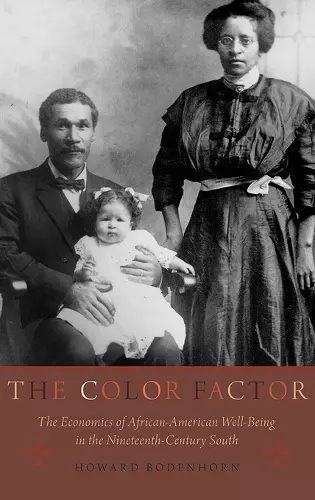The Color Factor
The Economics of African-American Well-Being in the Nineteenth-Century South
Format:Hardback
Publisher:Oxford University Press Inc
Published:25th Jun '15
Currently unavailable, and unfortunately no date known when it will be back

South Carolina's Indian-American governor Nikki Haley recently dismissed one of her principal advisors when his membership to the ultra-conservative Council of Conservative Citizens (CCC) came to light. Among the CCC's many concerns is intermarriage and race mixing. According to the Southern Poverty Law Center, in 2001 the CCC website included a message that read "God is the one who divided mankind into different races.... Mixing the races is rebelliousness against God. " Beyond the irony of a CCC member working for an Indian-American, the episode reveals America's continuing struggle with race, racial integration, and race mixing. The Color Factor shows that the emergent twenty-first-century recognition of race mixing and the relative advantages of light-skinned, mixed-race people represents a "back to the future " moment---a re-emergence of one salient feature of race in America that dates to its founding. Each chapter addresses from a historical perspective a topic in the current literature on mixed-race and color. The approach is economic and empirical, but the text is accessible to social scientists more generally. The historical evidence concludes that we will not really understand race until we understand how American attitudes toward race were shaped by race mixing.
In The Color Factor, Howard Bodenhorn provides a quite detailed examination of free black registers, tax records, and other primary and secondary sources for Maryland and Virginia in order to cast important new light on the still not fully understood aspects of the economic, social, and health differences between those considered to be mulatto and those regarded as black. This issue is not only of importance for historical studies but has significance for understanding the African-American community today. * Stanley Engerman, John Munro Professor of Economics, University of Rochester *
Howard Bodenhorn deftly explores the complexities of color and the status of people of black African ancestry during the slavery and post-slavery eras of 19th century America. The book is a tour de force. It is packed with new insights developed from economic reasoning, descriptions of the legal and social definitions of color, and careful analyses of a wide range of data sources that document the advantages on many socioeconomic dimensions experienced by lighter-skinned people of African descent. * Price V. Fishback, Thomas R. Brown Professor of Economics, Eller College of Management, University of Arizona *
A tour-de-force of interdisciplinary scholarship, Howard Bodenhorn creatively and exhaustively mines an astonishing array of archival materials to study quantitatively the social and economic effects of skin complexion in the early-nineteenth-century United States. Elegantly written, The Color Factor is required reading for scholars wishing to understand how changing economic, social, and political institutions affected the determination of racial identity and its consequences during a crucial period in American history. * Robert A. Margo, Professor of Economics, Boston University *
The Color Effect is a scholarly work that will influence the research agenda for the coming generations in antebellum economic history. * Scott Alan Carson, Journal of Economics *
ISBN: 9780199383092
Dimensions: 160mm x 234mm x 25mm
Weight: 723g
336 pages